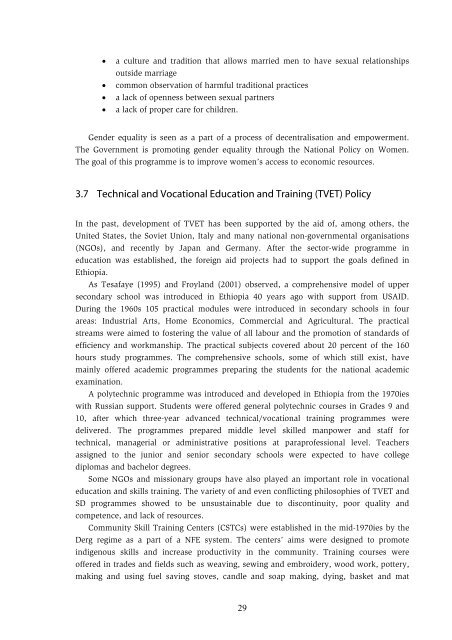Education and Training in Ethiopia An Evaluation of Approaching EFA Goals
Education and Training in Ethiopia - Koulutuksen tutkimuslaitos
Education and Training in Ethiopia - Koulutuksen tutkimuslaitos
- No tags were found...
You also want an ePaper? Increase the reach of your titles
YUMPU automatically turns print PDFs into web optimized ePapers that Google loves.
• a culture <strong>and</strong> tradition that allows married men to have sexual relationshipsoutside marriage• common observation <strong>of</strong> harmful traditional practices• a lack <strong>of</strong> openness between sexual partners• a lack <strong>of</strong> proper care for children.Gender equality is seen as a part <strong>of</strong> a process <strong>of</strong> decentralisation <strong>and</strong> empowerment.The Government is promot<strong>in</strong>g gender equality through the National Policy on Women.The goal <strong>of</strong> this programme is to improve women’s access to economic resources.3.7 Technical <strong>and</strong> Vocational <strong>Education</strong> <strong>and</strong> <strong>Tra<strong>in</strong><strong>in</strong>g</strong> (TVET) PolicyIn the past, development <strong>of</strong> TVET has been supported by the aid <strong>of</strong>, among others, theUnited States, the Soviet Union, Italy <strong>and</strong> many national non-governmental organisations(NGOs), <strong>and</strong> recently by Japan <strong>and</strong> Germany. After the sector-wide programme <strong>in</strong>education was established, the foreign aid projects had to support the goals def<strong>in</strong>ed <strong>in</strong><strong>Ethiopia</strong>.As Tesafaye (1995) <strong>and</strong> Froyl<strong>and</strong> (2001) observed, a comprehensive model <strong>of</strong> uppersecondary school was <strong>in</strong>troduced <strong>in</strong> <strong>Ethiopia</strong> 40 years ago with support from USAID.Dur<strong>in</strong>g the 1960s 105 practical modules were <strong>in</strong>troduced <strong>in</strong> secondary schools <strong>in</strong> fourareas: Industrial Arts, Home Economics, Commercial <strong>and</strong> Agricultural. The practicalstreams were aimed to foster<strong>in</strong>g the value <strong>of</strong> all labour <strong>and</strong> the promotion <strong>of</strong> st<strong>and</strong>ards <strong>of</strong>efficiency <strong>and</strong> workmanship. The practical subjects covered about 20 percent <strong>of</strong> the 160hours study programmes. The comprehensive schools, some <strong>of</strong> which still exist, havema<strong>in</strong>ly <strong>of</strong>fered academic programmes prepar<strong>in</strong>g the students for the national academicexam<strong>in</strong>ation.A polytechnic programme was <strong>in</strong>troduced <strong>and</strong> developed <strong>in</strong> <strong>Ethiopia</strong> from the 1970ieswith Russian support. Students were <strong>of</strong>fered general polytechnic courses <strong>in</strong> Grades 9 <strong>and</strong>10, after which three-year advanced technical/vocational tra<strong>in</strong><strong>in</strong>g programmes weredelivered. The programmes prepared middle level skilled manpower <strong>and</strong> staff fortechnical, managerial or adm<strong>in</strong>istrative positions at parapr<strong>of</strong>essional level. Teachersassigned to the junior <strong>and</strong> senior secondary schools were expected to have collegediplomas <strong>and</strong> bachelor degrees.Some NGOs <strong>and</strong> missionary groups have also played an important role <strong>in</strong> vocationaleducation <strong>and</strong> skills tra<strong>in</strong><strong>in</strong>g. The variety <strong>of</strong> <strong>and</strong> even conflict<strong>in</strong>g philosophies <strong>of</strong> TVET <strong>and</strong>SD programmes showed to be unsusta<strong>in</strong>able due to discont<strong>in</strong>uity, poor quality <strong>and</strong>competence, <strong>and</strong> lack <strong>of</strong> resources.Community Skill <strong>Tra<strong>in</strong><strong>in</strong>g</strong> Centers (CSTCs) were established <strong>in</strong> the mid-1970ies by theDerg regime as a part <strong>of</strong> a NFE system. The centers’ aims were designed to promote<strong>in</strong>digenous skills <strong>and</strong> <strong>in</strong>crease productivity <strong>in</strong> the community. <strong>Tra<strong>in</strong><strong>in</strong>g</strong> courses were<strong>of</strong>fered <strong>in</strong> trades <strong>and</strong> fields such as weav<strong>in</strong>g, sew<strong>in</strong>g <strong>and</strong> embroidery, wood work, pottery,mak<strong>in</strong>g <strong>and</strong> us<strong>in</strong>g fuel sav<strong>in</strong>g stoves, c<strong>and</strong>le <strong>and</strong> soap mak<strong>in</strong>g, dy<strong>in</strong>g, basket <strong>and</strong> mat29




![to read the full report [pdf, Amharic] - Ethiopian Review](https://img.yumpu.com/52737829/1/190x245/to-read-the-full-report-pdf-amharic-ethiopian-review.jpg?quality=85)











